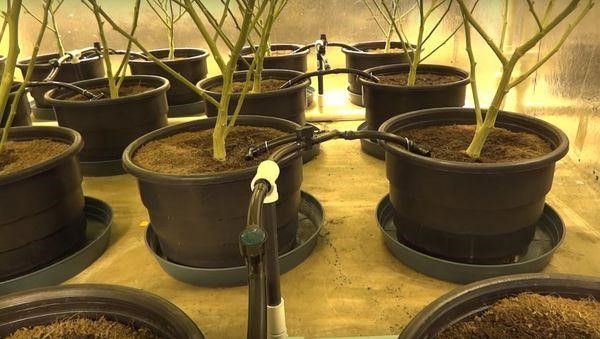- One of the keys to obtaining a good and productive harvest is, without a doubt, the way we water our plants.
- Depending on the amount of the time we can devote to this task or the budget we have, we will be able to choose one or another irrigation system.
- In addition, and as the most experienced growers know well, each variety has its own peculiarities, so we will have to know the amount of water required in each case, as well as the most suitable way of bringing the nutrients to them.

If there is a maxim in the world of cannabis cultivation, it is that not everything goes when it comes to taking care of our plants. If our purpose is that they grow healthy and strong, we must consider every detail. One of the most important of all is irrigation. Cannabis plants, like all living organisms, need food to grow, and we are responsible, not only to provide them with the most suitable nutrition, but also to determine the best way of supplying it to them.
When assessing what kind of culture is the most suitable for our harvest, we must take several factors into account: whether we will be growing indoors or outdoors, the type of substrate that we will use, the budget that we have ..., among others issues. Likewise, there are different watering systems aimed at adapting to each and every one of the situations in which cannabis can grow. Let's go through them to remove any doubt you may have when choosing which system is the most suited to your needs.
Manual watering
If the resources at our disposal are limited but, on the contrary, we can spend a lot of time caring for our plants, perhaps the best option is to go for manual watering. This means that, whenever needed, we will just take a recipient and water our crops.
How often should we water?
This type of irrigation entails many advantages but also some dangers. Newcomers to the world of self-cultivation often make some errors like, for example, overwatering. This can end up by damaging the roots and, as a consequence, growth stops and the plant acquires a light colour, different from its usual green tones. There is no precise technique to prevent this from happening. In fact, the most experienced growers suggest that the best indicator to know when water is needed is the weight of the pot.

The experts in this area recommend taking as a reference the effort we need to make in order to lift the pot. If the soil is too wet, the pot will weigh more and so the plant will have enough water for some time. But if it is dry, we will find that the pot is much lighter, and so, that the plant needs watering. We must learn to feel the plant's need for water by only lifting the pot. With the help of intuition, we will soon notice the difference in weight of the substrate, depending on whether it is more or less humid.
Rotation irrigation
If it is still too early for you to tell whether water is required or not only by the weight of the pot, there are other alternatives. To solve one of the main questions that usually arise, which is no other than for how long should we water our plants, there is a system that allows them to properly receive the nutrients while at the same time avoiding the dreaded puddles. This is the rotation irrigation system. Is consists of establishing a period of approximately three days, depending on the light and moisture conditions, during which different treatments are carried out.
On the first day, we must mix a nutrient solution with the water and water the plants with it, as needed, for a few minutes. The next day we will clean the tank and fill it with fresh water completely free of impurities i.e. distilled water. On the last day nothing needs to be done, just let them rest.
Flood irrigation
Even though it is more typical of outdoor culture and more particularly of the most experienced growers who opt for guerrilla growing (allowing weather conditions to be responsible for nurturing the plants), some people chose to replicate this same system on their indoor crops. The main purpose is to simply space watering days apart as much as possible.

So, whether indoors or outdoors, flood irrigation, consists of, as its name suggests, adding plenty of water to the ground so that it seeps through the substrate and slowly reaches the roots of the plants.
If growing outdoors, simply make grooves to guide the water and let it sit there. Thanks to this, the earth will get wet and there will be no problem if some days pass by before the next watering. Indoors it is different. We should place a tray under the pots and pour a large amount of water in them that will later filter up to the roots. These will give us a margin of five or even six days before watering again.
Tips
Several continued irrigations will be needed until the roots of the strains colonize the substrate and, therefore, have access to the water. For this very reason, avoid putting any type of element that could prevent the substrate from being in direct contact with the tray.
Automatic watering
In case we do not have time or simply our lack of memory has already played us some trick, we can install an automatic irrigation system. This way, it won't matter whether we are at home, out shopping or traveling: the system will function on its own, depending on when we have scheduled and arranged the watering. There are different types.

Drip irrigation
This system is connected through small tubes and droppers to bring water from a container or reservoir to each of plants in our crop. A timer or some other device (such as bomblets) must be added to it, to allow us to schedule the times when our plants will be watered. The main advantage of this type of irrigation is that it only takes to the strains the amount of water they require. Not a drop more, not a drop less, allowing us to save not only time but also water and money.
There are many drip irrigation systems that any grower, experienced or not, can install at home. However, the experts recommend that, if we opt for this system, we should discard using substrate and rather go for hydroponics, where the plants grow on a coconut base, rockwool or clay balls.
Sprinkler irrigation
Like the drip irrigation, this type of automatic system is activated when scheduled. The difference is that instead of providing the water individually in each pot, the water is dispersed on plants. To some extent, this can be positive, as it is distributed evenly and can thus prevent the formation of puddles. However, there are the same risks as with rain and dew: certain microorganisms may develop, such as mildew.
And you must never forget...
Whether we choose manual, automatic, drip or sprinkler irrigation, we must never leave out certain details that are key for our crops to grow healthy and strong. One of them is to prevent the water we use from being too cold. More experienced growers advise that it should be at a warm temperature, to avoid possible mishaps with our strains. Take the water the day before for the chlorine to evaporate and the water to reach room temperature. And of course, we must be ever vigilant when it comes to measuring both water pH levels (between 5.8 and 6.5 for cannabis cultivation) as well as the values of electroconductivity (EC). If you follow all these tips, your plants should have no problem to grow healthy and radiant.



Comments from our readers
There are no comments yet. Would you like to be the first?
Leave a comment!Did you like this post?
Your opinion about our seeds is very important to us and can help other users a lot (your email address won't be made public).